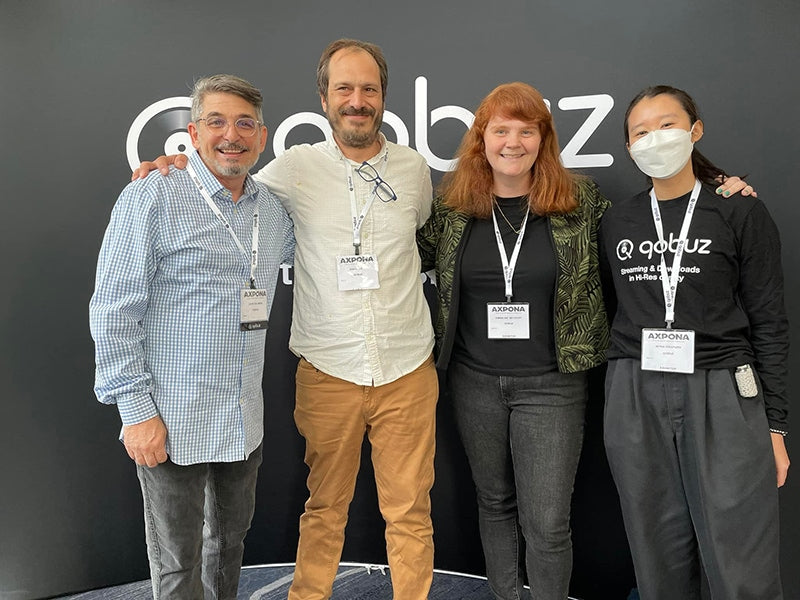Streaming and downloading audio service Qobuz specializes in delivering high-resolution audio up to 24-bit/192 kHz. Founded in 2007 in France, Qobuz launched in the US in February, 2019 and now operates in 25 countries throughout Europe and Latin America.
We interviewed Dan Mackta, Qobuz managing director, US (photo above), about Qobuz’s origins, philosophy, recent developments, and more.
Frank Doris: Could you give a brief outline of Qobuz and how it got started?
Dan Mackta: Qobuz is a French company based in Paris, started by classical musicians almost 15 years ago. It was originally a high-res download store, and evolved to open up the first high-res streaming service in the world. We finally opened up in the US in February of 2019, on Valentine’s Day.
We had time to establish ourselves before Amazon launched Music HD and Apple launched Lossless Audio, not a moment too soon.

FD: When did the light bulb go off when Qobuz decided, hey now’s the time for a high-res streaming service!
DM: I don’t know, but God bless them.
The current owners are not the founders. The guys who started the company were classical musicians dedicated to quality, but they weren’t great at other things, which is why the current ownership took over about five years ago.
FD: All your stuff is high-res.
DM: We’ve got one tier [of high-res audio only]; that makes us unique. The differences are that you can go monthly [subscription] or annual; you can do a family plan, or a duo plan, two subscriptions for a package price. We’ve got the high-res download store also. We’re not just a streaming service. And there are not that many places to buy high-res downloads; major services, streaming services don’t offer it.
For those for whom these things matter, we have as much 24-bit high-res as we can get from the labels, suppliers and creators. Everything that we have is at a minimum CD-quality, 16/44 – 80 million tracks or something like that. Also, there’s so much new stuff being released every single week. But last time I checked, [we had] about 3 million high-res tracks. It’s comparable with what the other guys should have.
FD: You don’t actually get master tapes and put them through some kind of machine that converts it all to high-res, correct? You’re getting the files from the record labels.
DM: Yes. We don’t do anything to them.
FD: And I guess some record labels care more about high-res than others.
DM: Well, they make more money from [offering high-res versions], at least with us. And there’s consumer demand. It’s not huge, but it’s enough. Otherwise, Apple and Amazon wouldn’t be offering it.

Qobuz people: David Solomon, Dan Mackta, Emmaline McCourt, and Nitha Viraporn.
FD: You hear so much talk about the fact that the average consumer doesn’t care about high-end audio and they’re happy listening through phones and crappy earbuds. I’ve never believed that.
DM: When it comes to music listening, there’s really no such thing as a [typical] consumer. Everybody has their own way that they listen. Most people, if they knew they could easily get better sound quality, would want it. It’s just that they haven’t heard of it. That’s part of [our] challenge.
FD: How do you make people aware?
DM: Well, it’s a big challenge because our marketing budgets are insubstantial. (laughter) I feel like I’m 12 years old again going door to door, selling magazine subscriptions to try and win a clock radio or something.
Selling subscriptions but also trying to establish a brand. Also, just trying to educate consumers in general about what’s available. Because we’re small, it’s been about knowing the audience; we’ve definitely focused on people who already know what high-res is. It’s a lot easier to convince someone who already knows…
FD: …what good sound is all about.
DM: And then I think it’s been about finding and featuring cool, unusual music, and being able to market mainly through stuff that doesn’t cost a lot of money: social media, YouTube and stuff like that. With artists that have a platform or constituency, recommending us [is] meaningful. It’s about just letting people know there’s a [high-quality] alternative. Some people like that we’re a smaller company, not a multibillion-dollar international juggernaut that also [happens to offer] streaming.
Our new-releases programming and our playlists are driven by more of an old-school record store vibe. Hey, here are a couple dozen of the coolest new albums out this week; we’re putting ’em up “in front of the store.” We’re like a very cool record store that doesn’t necessarily care what the flavor of the month is. We’re not trying to be exactly the same thing as all these super-mainstream players.
FD: There’s so much music out there that people need to have a filter.
DM: Thousands of new releases are pitched every week. There’s huge amount of material coming in. We listen to it all, [but] rock, jazz and classical are our biggest genres for our audience.
FD: So, who picks that stuff? Is it you, or is it a staff of one hundred? (laughter)
DM: It’s a staff of about a dozen across the world. It’s not a lot of people. We look for a certain vibe or certain focus; we just know what our audience is looking for. It’s not a workout playlist!
FD: What kind of efforts do you have to make to get the best-possible high-res masters?
DM: A lot of stuff comes in like a fire hose every week from our distributors and partners. {Sorting through it] is a huge job.
We’re at the mercy of the record labels for the most part. [On the other hand], A&R people are constantly looking at what they have and figuring out how to make more money from it, which means how to reissue it in a way that’s gonna get people to care about it again. And there’s certainly an effort; everybody is remastering or doing 24-bit transfers. We generally know when stuff is coming, and we work with the [labels] to plan out marketing and promotion. For example, knowing when a big drop of Frank Zappa is coming.
We get the [high-res] files and apply no volume normalization. We do no digital signal processing. Nothing. We may offer a volume-normalization option later.
FD: Qobuz just made an announcement regarding a partnership where you will be offering some songs with THX Spatial Audio encoding. Tell us about that, and why you decided to get into it.
DM: THX is obviously a respected brand that’s done a lot of different things over the years. They brought this THX Spatial Audio format to my attention. It’s big in gaming. Up until now its primary use case has been in gaming. But they’ve been trying to get more artists to try it and we decided it would be fun to work with them. It was easy to do because THX Spatial Audio is delivered as regular 2-channel audio, so no decoder is required.
It’s designed to be used with headphones and to get the sound “out of” your head. It’s not as extreme-sounding as some of the other sound-processing headphone formats. It allows the engineer to create a more 3D sound space. We were able to get some very cool eclectic artists.
Here are links where you can listen to THX Spatial Audio:
“Double Dare” by Circuit des Yeux
“Calling Vic Juris” by Anat Cohen
“Whenever You’re Ready” by Dinosaur Jr.
FD: The one question I have to ask everybody is: how has the pandemic affected you?
DM: Thankfully, nobody on our team or anybody’s families were had any serious health impacts. Qobuz had a huge boost at the beginning of the pandemic. A massive explosion. It calmed down in 2021 but overall, I think it poured gasoline on our growth in the US.
FD: In a recent interview I said that it’s sobering to know that there’s much more music out there than you can listen to in a lifetime.
DM: It’s probably [more like] more music is released in a month than you could listen to in a lifetime.
The most fun part of Qobuz for me, as a music person, is being able to be involved in the delivery chain in a way that feels really respectful of the artists.
FD: Are there any technological advancements you foresee for streaming or digital audio, or where might things be going?
DM: Well, you keep hearing about advancements in Bluetooth and higher-bit-rate Bluetooth. [I also think] we’ll see more and more lifestyle products that sound good and are designed to work with high-res audio.

All images courtesy of Qobuz/Shore Fire Media.

0 comments